Got tiny bugs buzzing around your fruit bowl? You’re likely dealing with fruit flies! These common kitchen pests can be a real nuisance, but thankfully, getting rid of them is easier than you think. You don’t need harsh chemicals or expensive gadgets – simple DIY methods using household items can effectively eliminate these unwanted guests.
Having recently battled a fruit fly invasion in my own home, I decided to put various elimination techniques to the test. After meticulous experimentation and note-taking, I’m excited to share the most effective fruit fly traps and how to make them yourself.
These homemade traps are not only easy to assemble but also rely on natural, readily available ingredients. They’re perfect for a DIY enthusiast and those seeking chemical-free solutions. Plus, if you’re feeling kind, some of these traps even offer a humane way to relocate fruit flies outdoors. Beyond traps, we’ll also explore essential prevention tips to keep your kitchen fruit fly-free in the first place.
Understanding Fruit Flies
Fruit flies are small, winged insects that are strongly attracted to ripe and fermenting fruits and vegetables – their name is quite descriptive! They also flock to sugary substances like beer, wine, and juice. You’ll often find them hovering around fruit bowls, garbage disposals, trash cans, and even sink drains. They are tiny, about the size of a grain of rice, and resemble small, tan or brownish houseflies with distinctive red eyes. Fruit flies are most prevalent during warmer months, particularly summer and late fall when fruits are abundant.
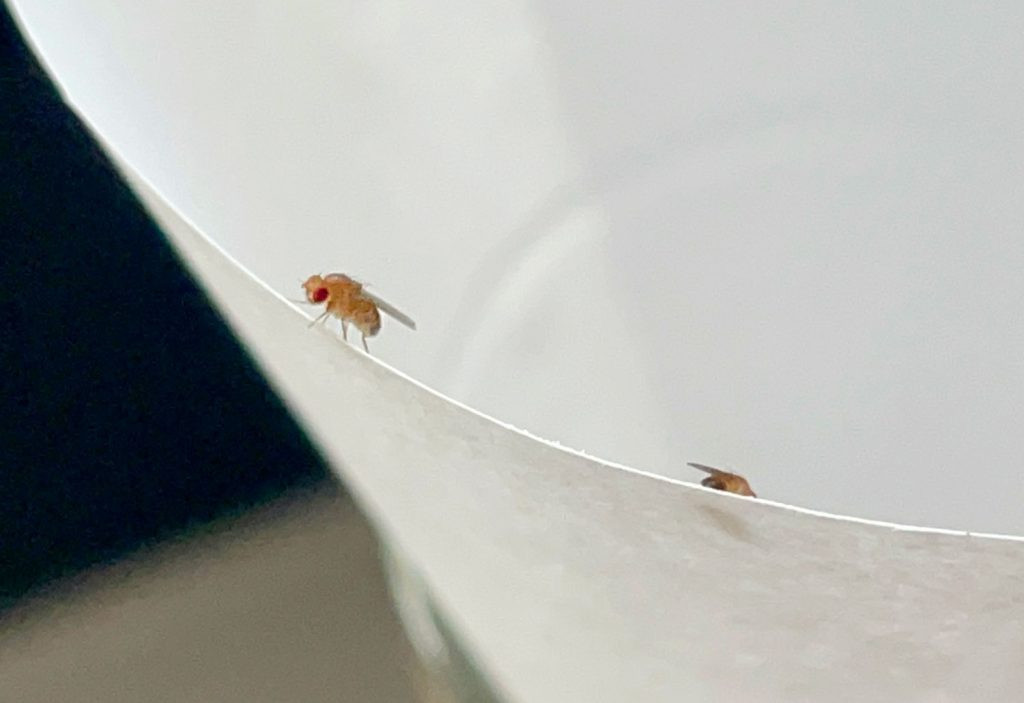 Close Up Of Fruit Fly On Paper Funnel
Close Up Of Fruit Fly On Paper Funnel
A fruit fly problem often starts with just a few individuals hitching a ride on produce brought from the store. However, female fruit flies are prolific breeders, capable of laying hundreds of eggs in their short lifespan. These eggs can hatch in as little as 12 hours, and the flies can reach adulthood within days. This rapid life cycle means a small initial infestation can quickly explode into a large-scale problem. Therefore, prompt action is key to get rid of fruit flies and prevent a full-blown infestation.
Fruit Flies vs. Fungus Gnats vs. Drain Flies: Identification Matters
It’s easy to mistake fruit flies for other small flying insects commonly found indoors, especially fungus gnats and drain flies. Accurate identification is crucial because different pests require different control methods. The easiest way to tell them apart is by observing where you see them and what larger insect they resemble.
- Fruit flies: Resemble tiny flies and are found near fruit bowls, trash, and food sources.
- Drain flies: Look like small, fuzzy moths and are typically seen near sinks and drains.
- Fungus gnats: Look like small mosquitoes and are usually found near houseplants, as they breed in damp potting soil.
If you are uncertain about the type of pest you’re dealing with, try one of the traps described below. If it attracts the insects in your home, you most likely have fruit flies!
4 Simple DIY Fruit Fly Traps That Really Work
Eradicating fruit flies doesn’t have to be a complicated or expensive process. You likely already have everything you need right in your kitchen. The core principle of each trap is simple: attract the fruit flies and prevent their escape. I tested four popular DIY methods, and while all showed some effectiveness, one clear winner emerged. Since each method utilizes common household items, experimenting with a few is easy and worthwhile. Think of it as a fun, mini science experiment in your kitchen! Here are the first four homemade fruit fly traps I tested:
- Funnel Trap
- Plastic Wrap Trap
- Dish Soap Trap
- Rotting Fruit Trap
Let’s delve into the details of each method, including step-by-step instructions and my personal verdict on their effectiveness. Keep in mind that some traps work faster than others, and complete eradication may take a few days, regardless of the technique you choose.
#1: The Paper Funnel Fruit Fly Trap
This classic trap design lures fruit flies into a container through a narrow opening at the bottom of a paper funnel. Once inside, the flies struggle to navigate back out through the small hole, effectively trapping them.
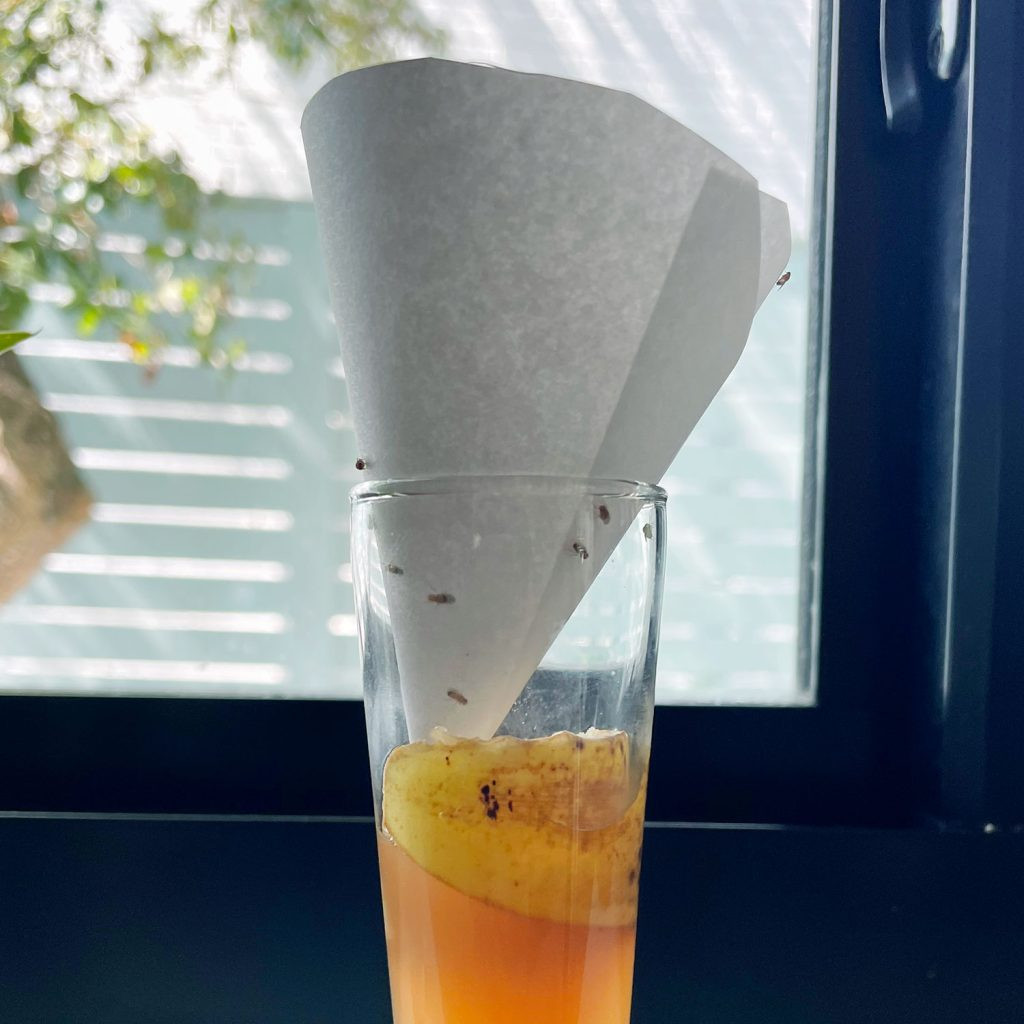 DIY Fruit Fly Trap With Paper Funnel
DIY Fruit Fly Trap With Paper Funnel
Supplies:
- Small, clear jar, cup, or container (narrow opening preferred)
- Sheet of paper or cardstock
- Tape
- Scissors
- Apple cider vinegar (ACV)
Instructions:
- Choose your container: Select a small, clear container like a mason jar or recycled glass jar. A narrow opening is beneficial for this trap design.
- Add the bait: Pour a small amount of apple cider vinegar, old beer, or wine into the bottom of the container. These liquids are irresistible to fruit flies.
- Create the funnel: Shape a piece of paper or cardstock into a cone with a very small opening at the pointed end. Secure the cone shape with tape. You can create the small opening by cutting the tip of the cone if needed. Aim for an opening about the size of a grain of rice.
- Assemble the trap: Place the paper funnel into the opening of your container, ensuring the wide end rests securely on the rim. You may need to adjust the funnel’s shape so it sits just above the liquid without touching it. Seal any gaps between the funnel and container opening to prevent fly escape.
- Humane release (optional): To release trapped fruit flies outdoors, carefully transport the entire trap outside without disturbing the funnel (to avoid escape). Then, remove the funnel and allow the flies to fly away.
While store-bought funnels can be used, they often have openings that are too wide, making it easier for trapped fruit flies to escape. Homemade paper funnels offer a more customizable and effective solution.
#2: The Plastic Wrap Fruit Fly Trap
Similar to the funnel trap, this method uses the enticing scent of apple cider vinegar to attract fruit flies. Plastic wrap secured over the container opening with small holes allows flies to enter, but makes it difficult for them to find their way back out.
Supplies:
- Small, clear jar, cup, or container
- Rubber band
- Plastic wrap or plastic bag
- Toothpick
- Apple cider vinegar (ACV)
Instructions:
- Select your container: Choose a small, clear jar, cup, or glass container. Clarity helps you monitor trap effectiveness, but even a can will work.
- Add the lure: Pour apple cider vinegar into the container. Old beer or wine are also effective alternatives, but avoid regular white vinegar.
- Seal with plastic wrap: Tightly stretch plastic wrap over the container opening and secure it with a rubber band. You can use kitchen plastic wrap or cut a piece from a plastic bag.
- Poke entrance holes: Use a toothpick to carefully poke a few small holes in the plastic wrap. The holes should be just large enough for fruit flies to enter.
- Optional humane release: To free the trapped flies outside, carefully take the trap outdoors, ensuring the plastic wrap remains in place. Remove the plastic wrap outdoors to release the flies.
Alternatively, you can create a similar trap using a metal jar lid. Puncture a small hole in the lid using a hammer and nail, then screw the lid onto a mason jar or old food jar containing the bait.
#3: The Simple Dish Soap Fruit Fly Trap
This trap is the easiest to assemble, requiring no cover at all. It relies on the principle of surface tension. Dish soap disrupts the surface tension of the bait liquid, causing fruit flies to sink and drown when they land on it. Note: This method is not designed for humane release, as the soap is lethal to the flies.
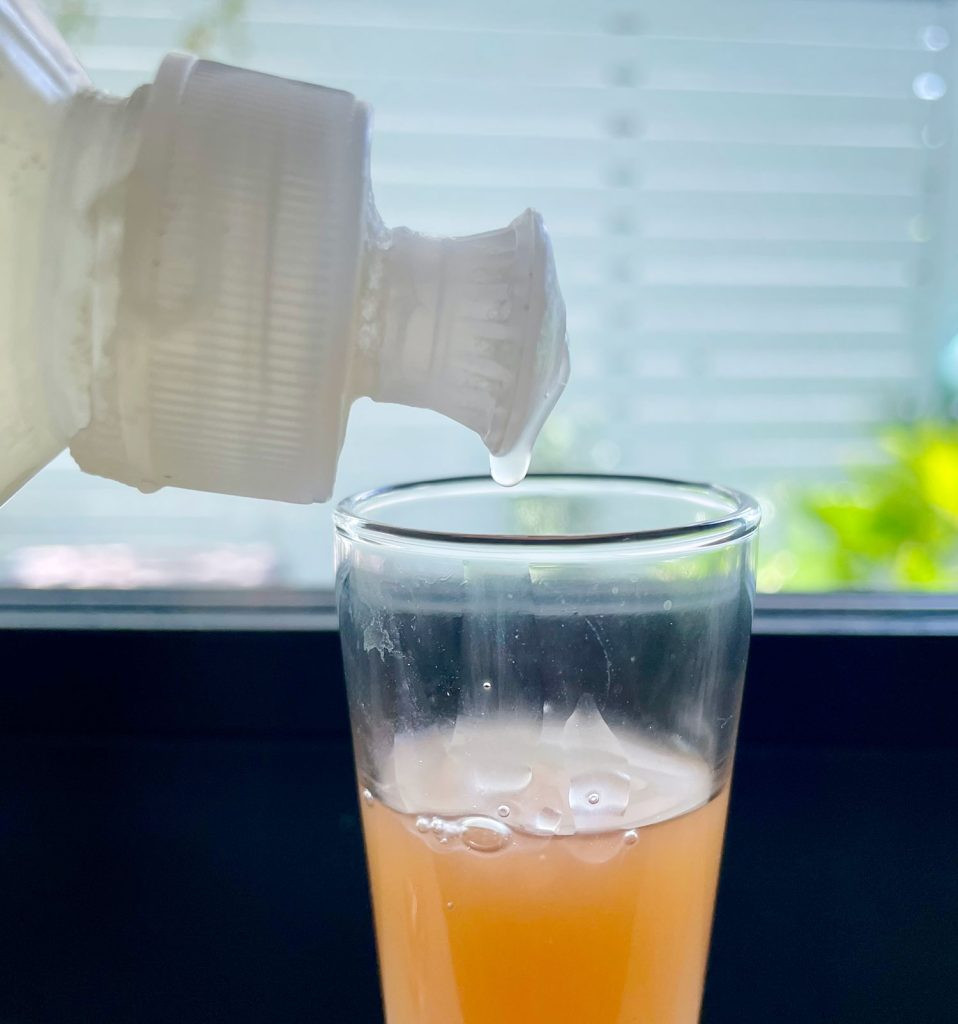 Dripping Dish Soap Into Apple Cider Vinegar For DIY Fruit Fly Trap
Dripping Dish Soap Into Apple Cider Vinegar For DIY Fruit Fly Trap
Supplies:
- Small container, bowl, or dish
- Dish soap
- Apple cider vinegar (ACV)
Instructions:
- Prepare the bait: Fill the bottom of a small container, bowl, or dish with apple cider vinegar. The sweet scent will attract fruit flies.
- Add dish soap: Add a few drops of dish soap to the apple cider vinegar and gently mix. The soap will break the surface tension of the liquid.
For enhanced effectiveness, you can combine this method with the plastic wrap or funnel trap. Simply add dish soap to the apple cider vinegar before covering the container. This creates a double-layered trap, increasing the chances of trapping and eliminating fruit flies.
#4: The Rotting Fruit Fruit Fly Trap
For a more potent lure, consider using actual fruit, which is naturally irresistible to fruit flies.
Supplies:
- Small glass jar, cup, or container
- Plastic wrap or paper funnel (depending on your chosen trap style)
- Small piece of ripe fruit, such as banana peel or apple slice
Instructions:
To create a rotting fruit trap, simply replace the apple cider vinegar in either the Plastic Wrap Trap or Funnel Trap with a piece of banana peel, apple slice, or peach. You can also enhance the attractiveness by adding a fruit scrap to your apple cider vinegar bait. Be sure to replace the fruit scrap every day or two to prevent unpleasant odors in your kitchen and maintain optimal trap effectiveness.
Which Fruit Fly Trap Works Best?
During my fruit fly experiment, I set up four distinct DIY traps to compare their performance. The traps I tested were variations of the techniques described above:
- Plastic Wrap Trap with banana peel
- Funnel Trap with ACV + banana peel
- Plastic Wrap Trap with ACV + dish soap
- Dish Soap Trap with ACV
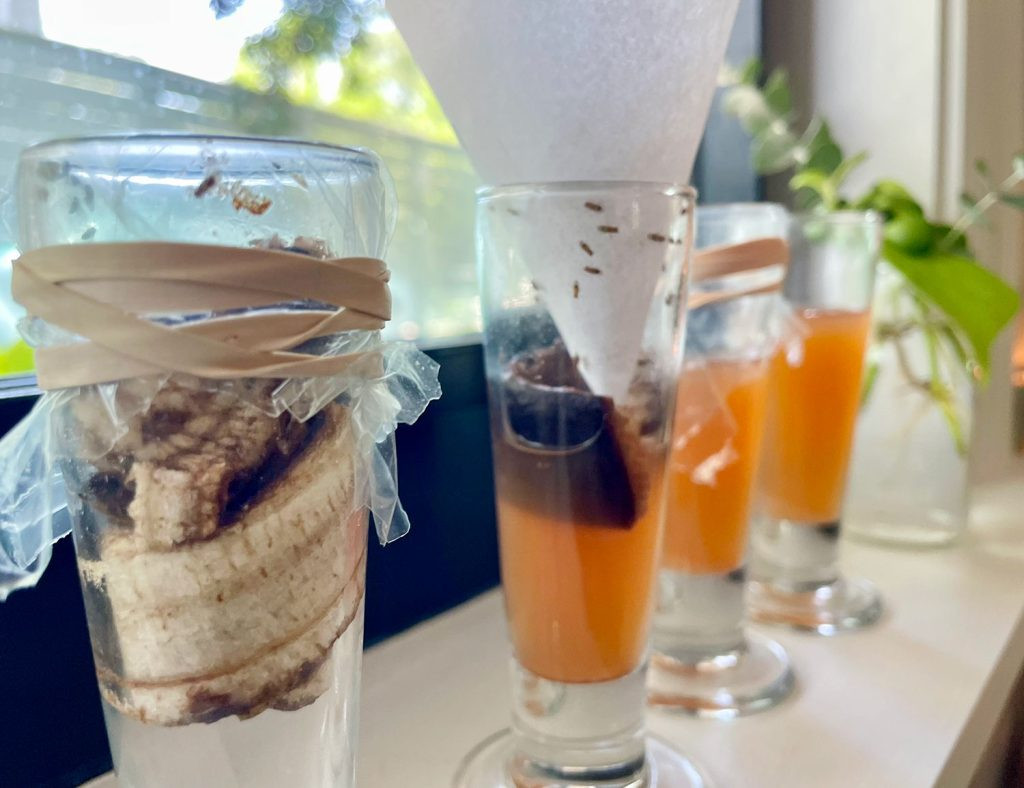 4 DIY Fruit Fly Traps Close Up
4 DIY Fruit Fly Traps Close Up
My results indicated that the type of bait was a more significant factor than the trap design itself. Traps using banana peel as bait consistently outperformed those using apple cider vinegar. The two Plastic Wrap Traps were virtually identical in construction, yet the banana peel trap captured significantly more fruit flies than the ACV and dish soap trap. Perhaps apple cider vinegar is less appealing when real fruit is present nearby?
Based on my findings, I recommend incorporating a piece of fruit scrap into any trap you choose to set up. While both trap designs were effective, I slightly preferred the plastic wrap trap due to its ease of construction and greater stability. I accidentally knocked over the funnel trap once, releasing some captured flies back into the kitchen – oops!
The Ultimate Fruit Fly Bait Experiment
Intrigued by the success of fruit scraps, I decided to further investigate which type of fruit serves as the most effective bait. I tested three readily available fruits: banana peel, apple slices, and a strawberry. Each fruit was placed in a separate Plastic Wrap Trap and positioned side-by-side on my kitchen counter for 24 hours.
While the banana peel initially seemed promising (it was the ripest at the start), the fruit flies ultimately showed the strongest preference for the strawberry. The banana peel still attracted a fair number of flies, but the strawberry became increasingly irresistible as it ripened further. Surprisingly, the apple slices didn’t catch a single fruit fly!
Store-Bought Fruit Fly Traps: A Convenient Alternative
If DIY methods aren’t working for you, or if you prefer a ready-made solution, numerous store-bought fruit fly traps are available. These traps have garnered thousands of positive reviews and are generally affordable, typically costing less than $20. They can be a worthwhile option if you’re seeking a trap that targets a broader range of flying insects or if you desire a more discreet trap design compared to homemade versions.
 Collage of Storebought Fruit Fly Traps
Collage of Storebought Fruit Fly Traps
During my experiment, I purchased a pack of Terro Fruit Fly Traps to compare their performance against my DIY traps. I placed a Terro trap next to my banana and strawberry traps for 24 hours to assess which performed best.
Again, my homemade strawberry trap emerged as the winner, closely followed by the homemade banana peel trap. The store-bought trap only captured a single fruit fly during this initial 24-hour period. HOWEVER…
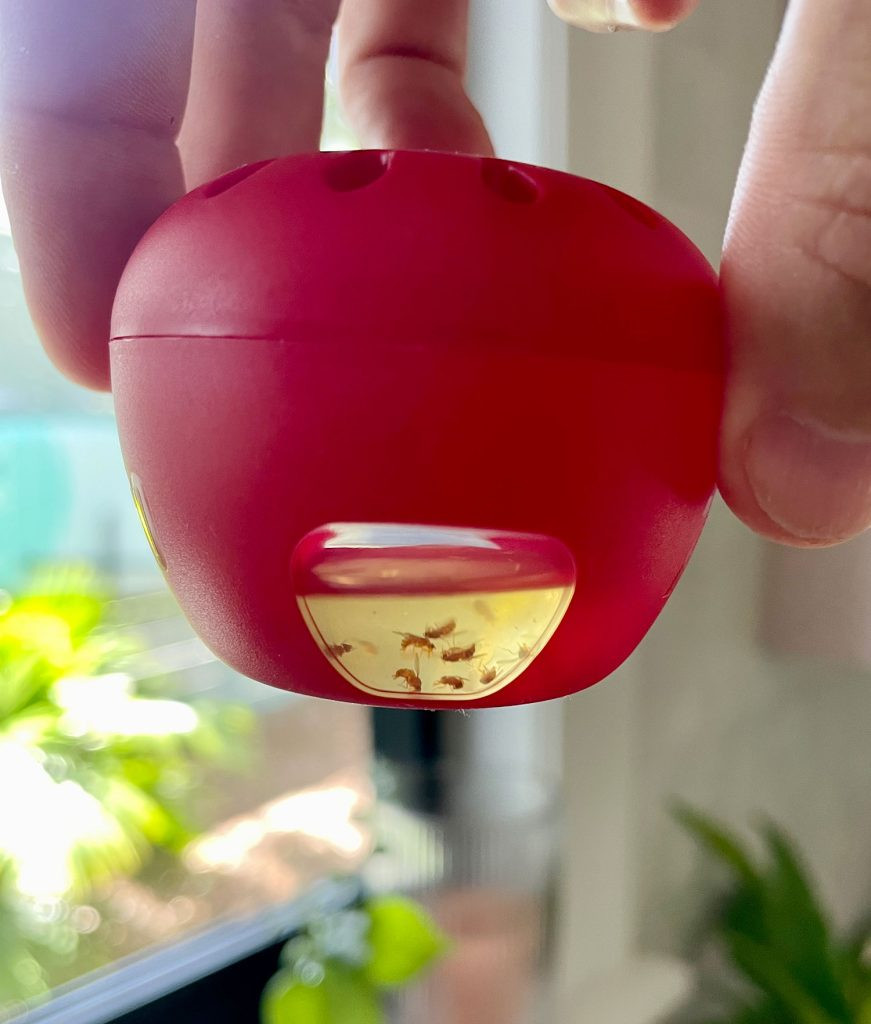 Terro Fruit Fly Trap With Dead Fruit Flies Visible
Terro Fruit Fly Trap With Dead Fruit Flies Visible
To ensure a fair comparison, I discarded my DIY traps and left the store-bought trap in place for another 24 hours. Over this extended period, the Terro trap accumulated a significant number of fruit flies, as shown in the image above. This demonstrates that store-bought traps are indeed effective, although they may not work as quickly or aggressively as homemade traps.
My verdict? Store-bought traps are a good choice if you want a more aesthetically pleasing option, especially if you intend to leave the trap out long-term. However, for rapid fruit fly elimination, homemade traps proved to be the most effective solution in my experience!
Prevent Fruit Flies: Stop Infestations Before They Start
While eliminating fruit flies is relatively straightforward, preventing them from invading your kitchen in the first place is even better. Here are simple preventative measures you can incorporate into your routine:
- Maintain clean kitchen surfaces: Regularly wipe down kitchen counters, stovetops, tables, and any surfaces that can accumulate food residue or spilled liquids. Fruit flies are particularly drawn to fruit, sugary juices, and alcohol, so promptly clean up any spills.
- Empty your trash frequently: Food scraps left in your garbage can overnight can quickly transform it into a fruit fly breeding haven. Take out your trash daily to minimize attractants.
- Dispose of overripe fruit promptly: Monitor your fruit bowl and discard any browning or rotting fruits (apples, bananas, etc.) before they become a fruit fly magnet.
- Wash produce immediately upon bringing it home: Washing fruits and vegetables as soon as you get them home from the grocery store (except for berries, which may spoil faster with washing) can eliminate any fruit fly eggs or larvae that may be present on the surface.
- Refrigerate produce whenever possible: Fruit flies struggle to thrive in cold temperatures. When in doubt, store your fruits and vegetables in the refrigerator to deter infestations.
- Clean your sink drain regularly: Food particles trapped in your sink drain can attract fruit flies. Run your garbage disposal and flush the drain with hot water and a drain cleaner regularly to eliminate food debris.
Finally, don’t panic if you spot fruit flies in your home. While swift action is advisable to prevent the problem from escalating, the solutions outlined in this guide are easy, effective, and fast-acting. You might even find yourself enjoying the process of becoming a fruit fly scientist, just as I did!
*This post contains affiliate links, so we may earn a small commission when you make a purchase through links on our site at no additional cost to you.
